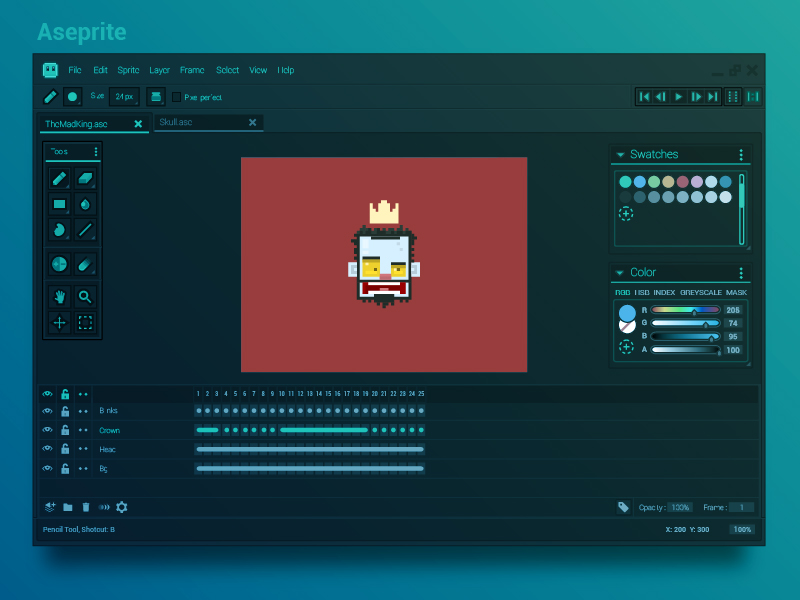

If you want more information on the command line, Aseprite has a really good guide on how to use it, check it here! Now what If you don’t know how to do that, on Windows you can Shift+Right click on a folder and select “Open Windows PowerShell window here”.Īnd then we do the fun part, the actual command line! Just type this (replace myFile with your filename) and press enter: Aseprite.exe -b '.\myFile.aseprite' -save-as ' is the tag that will replace the filename with the slice name and crop it. Now, save your Aseprite file and open your favorite command line tool on that file’s folder. Now, the command line! If you’re mainly an artist, this part can sound a little scary but I promise that after you get the hang of it and set everything up, this will automate a lot of the boring work when exporting files.įirst you will need to have Aseprite in your PATH, if you are unsure what I mean by that, follow this tutorial and add the Aseprite.exe path to your environment variable “PATH”. When saving an animation as png, Aseprite will create an image sequence, which looks something like this: Do not attempt to use any video format, unless you are making something very specific. Animations should be saved as image sequences or sprite sheets.Ideally the sprite should be scaled by the engine and all files should have their real resolution. Unless you have a really good reason, never ever scale your pixel art for exporting to the game engine.Just don’t use jpg, mp4, or any other lossy compressed format. It’s light, relatively fast to unpack, and has a really good transparency support. Let’s start with the file format: while some engines will accept tiff, gif, or even bmp, it’s usually a good idea to use png.Game engines are vastly different and each one will require you to do specific things, but there are usually some common practices: If you’re not sure what that means, don’t worry, it won’t change anything for you.Įxport for Twitter: A handy checkbox that makes the last frame of an animation have half of the duration, which makes the twitter mp4 loop perfectly! Saving for the engine They should be pretty intuitive, but if you want to know more, they are very easy to experiment with.Īpply pixel ratio: This is not very common, but if you’re using a non-square pixel, this will flatten that to square pixels. png, Aseprite will save it in multiple files, one for each frame.Īnimation direction: Here you can see the most common directions like “forward”, “backward” and so on, and pick the one that’s best for your animation. If you save in a format that doesn’t support animation, such as.gif, the animation will be exported to this file. If you save in a format that supports animation, such as.If you have more than one frame, two things can happen: This is a handy property that allows you to choose which layers you want to keep.įrames: I’ll get into more detail in the next section, but here is where you choose which frames you want to export. Layers: When you export a file you will flatten it, which means it’ll lose all layer information. Usually 200% or 300% are good enough for posting online. If you really need it to fit somewhere, try resizing using the closest smallest whole number and then extend the canvas to the size you need. Always resize your art using whole numbers (200%, 300% and so on) and never fractions (130%, 250%). That’s a very strong limitation of the pixel art medium and there aren’t many ways around it. This is because if you scale it to a number that’s not whole, your pixel art will look broken and weird. You probably noticed that you can only increase the scale of the image by 100%’s but no fractions, like 250%.

Resizing in whole numbers versus resizing in fractions Some edge cases exist, like printing pixel art to a really big billboard. While it’s possible to create something that looks like pixel art on vector, or exporting pixel art into vector format, it’s rarely done. The main drawback is that it’s hard to use it for detailed images like photos, and you have very little fine control on the pixel scale. Vector images are mostly a collection of points, line coordinates, and color information, which makes them very useful por creating images that can be rescaled into pretty much any resolution. If we simplify a lot, there are basically two types of 2D image files: bitmap and vector. Let’s start talking about how images are saved in the computer. I’ll get a bit technical here so feel free to skip paragraphs of things you are not interested in. This article was supported by Patreon! If you like what I’m doing, please consider supporting me there.Īlso, this is the part 8 of a series of articles, read the whole series in the Pixel Grimoire.


 0 kommentar(er)
0 kommentar(er)
